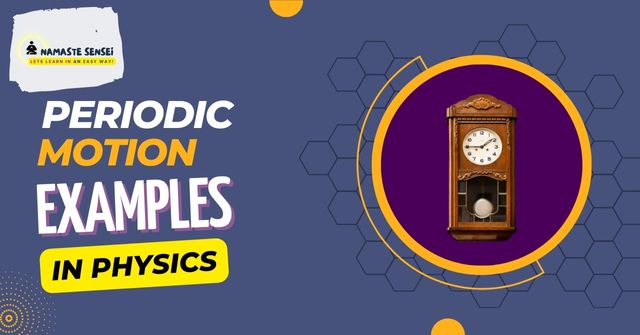10 Periodic Motion Examples In Physics & Daily Life
Here are the top 10 periodic motion examples In Physics and everyday Life.
-
Simple Pendulum (e.g., a weight attached to a string swinging back and forth).
-
Child on a Swing (moving back and forth on a swing set).
-
Ferris Wheel (the circular motion of the wheel as it rotates).
-
Vibrating Guitar String (the oscillation of a plucked or strummed string).
-
Tuning Fork (the vibration of a tuning fork when struck).
-
Dance of a Metronome (the rhythmic back-and-forth motion of a metronome).
-
Earth’s Rotation (the spinning of the Earth around its axis, causing day and night).
-
Heartbeat (the rhythmic contraction and relaxation of the heart).
-
Tides (the rising and falling of sea levels caused by the Moon’s gravitational pull).
-
Ocean Waves (the up and down motion of waves on the shore).
Periodic motion is a form of motion that occurs in regular, predictable intervals. Examples of periodic motion can be found all around us in everyday life. From the simple pendulum to the child on a swing, there are numerous examples of periodic motions that we see and hear every day.
In this blog post, we will explore 10 examples of periodic motion that can be seen in the world around us. By understanding the concept of periodic motion, we can better appreciate the natural phenomena that occur in our daily lives.
-
But before you read any further, it might be a good idea to understand what is periodic motion In Physics briefly. It will help you to understand the examples better. If you are already familiar with the concept, you can skip it by clicking on the link below.
Skip to examples:
What is periodic motion in physics?
Periodic motion refers to a type of motion that repeats itself in a regular and predictable manner over time. In other words, an object exhibiting periodic motion moves in a pattern that recurs at regular intervals. This repetitive pattern is often characterized by the motion of the object returning to its original state or position after a fixed amount of time has elapsed.
Key characteristics of periodic motion include:
- Period: The period is the time it takes for one complete cycle of motion to occur. It is the duration between two successive occurrences of the object being in the same state or position. The period is typically denoted by the symbol “T” and is measured in seconds.
- Frequency: The frequency is the number of complete cycles or oscillations that occur in one second. It is the reciprocal of the period and is measured in Hertz (Hz). The frequency is denoted by the symbol “f,” and it is related to the period as follows: f = 1/T.
Difference between Periodic and Oscillatory Motion
It is important to remember that:
- While all periodic motion is oscillatory, not all oscillatory motion follows a regular and repetitive pattern. Some oscillatory motions might be irregular and lack the predictable nature of periodic motion.
- Example of Non-Periodic Oscillatory Motion: An example of non-periodic oscillatory motion is a car moving along a bumpy road. As the car encounters bumps and irregularities, it experiences up-and-down oscillations. However, the bumps and unevenness in the road create a constantly changing environment, making the oscillations irregular and unpredictable. While the motion is still oscillatory (due to the up-and-down movement), it is not periodic because there is no fixed time for the car to complete one full cycle of motion.
Now let’s dive into the 10 periodic motion examples in physics & real life.
Periodic Motion Examples In Physics & Daily Life Explained
I am sure that the concept of periodic motion is clear to you now. If not, you can comment below. Let us now move on to 10 examples of periodic motion in physics & in real life.
Periodic Motion Examples
-
Simple Pendulum:

A simple pendulum consists of a small mass (the weight) attached to a string or rod that is free to swing back and forth. When you pull the weight to one side and release it, it swings under the force of gravity. As it swings to one side, it gains potential energy, which is then converted into kinetic energy as it returns to the other side.
The pendulum’s motion is periodic, with each swing taking the same amount of time, known as its period. The period depends on the length of the pendulum and gravity’s acceleration, making it a predictable and repetitive motion. -
Child on a Swing:

When a child sits on a swing and moves back and forth, they are experiencing periodic motion. As the child moves away from the center, the swing gains gravitational potential energy.
As they swing back toward the center, this potential energy is converted into kinetic energy. This continuous energy exchange allows the child to swing back and forth with a consistent period, creating a periodic motion. -
Ferris Wheel:

A Ferris wheel consists of multiple seats attached to a rotating wheel. As the wheel rotates, the seats move in circular paths. The motion of each seat is periodic, completing one full circle in a fixed amount of time, which is the period of the Ferris wheel’s motion.
The circular motion is maintained by a motor that continuously provides energy to keep the wheel turning, allowing people to enjoy the periodic ride. -
Vibrating Guitar String:
When a guitar string is plucked or strummed, it vibrates back and forth. These vibrations produce sound waves, creating musical notes.
The motion of the vibrating string is periodic, with each cycle of motion corresponding to one complete back-and-forth movement. The frequency of the vibration determines the pitch of the sound produced. -
Tuning Fork:

A tuning fork is a metal instrument with two prongs. When struck, the prongs vibrate back and forth, producing a distinct sound with a specific pitch. The motion of the vibrating prongs is periodic, with each cycle corresponding to one complete vibration. Tuning forks are often used as reference frequencies for tuning musical instruments. -
Dance of a Metronome:

A metronome is a device used to keep a steady rhythm during music practice. It consists of a weight on a rod that swings back and forth like a simple pendulum. The motion of the metronome is periodic, and its speed can be adjusted to set the tempo of the music. -
Earth’s Rotation:
The Earth rotates around its axis, causing day and night. This rotational motion is periodic, with one full rotation taking approximately 24 hours, known as a day. As the Earth rotates, different parts of the planet experience daylight and darkness in a predictable and repetitive manner. -
Heartbeat:
The heartbeat is the regular “thump-thump” sound your heart makes as it squeezes and relaxes. It does this rhythmically to pump blood throughout your body. This repeating pattern of squeezing and relaxing is called periodic motion. Each complete “thump-thump” cycle is one heartbeat. The heart keeps beating at a predictable and steady pace, making it an example of periodic motion. -
Tides:

Tides are the periodic rise and fall of sea levels caused by the gravitational pull of the Moon and, to a lesser extent, the Sun.
As the Earth rotates, different parts of the oceans experience the gravitational forces differently, resulting in a regular pattern of high and low tides approximately every 12 hours and 25 minutes. -
Ocean Waves:

Ocean waves are formed by the transfer of energy from the wind to the water’s surface. As the energy travels through the water, it causes the water to move up and down, creating the characteristic up-and-down motion of waves on the shore. Each wave has a specific wavelength and frequency, making the motion periodic.
References
- The Physics Classroom: Periodic Motion
If you are interested in learning about periodic motion and waves, it could be a valuable educational resource to explore. It is provided by the physics classroom.
You have finished the complete article related to 10 periodic motion examples in physics & in daily life. If you have any doubts or queries, feel free to comment below. We will respond as soon as possible.
Or Email Us At [email protected]


